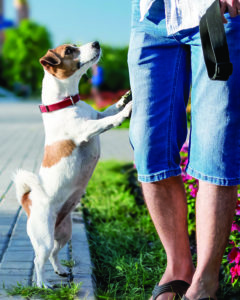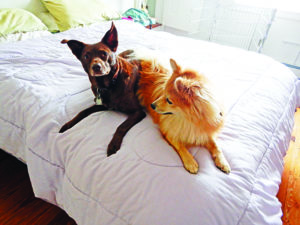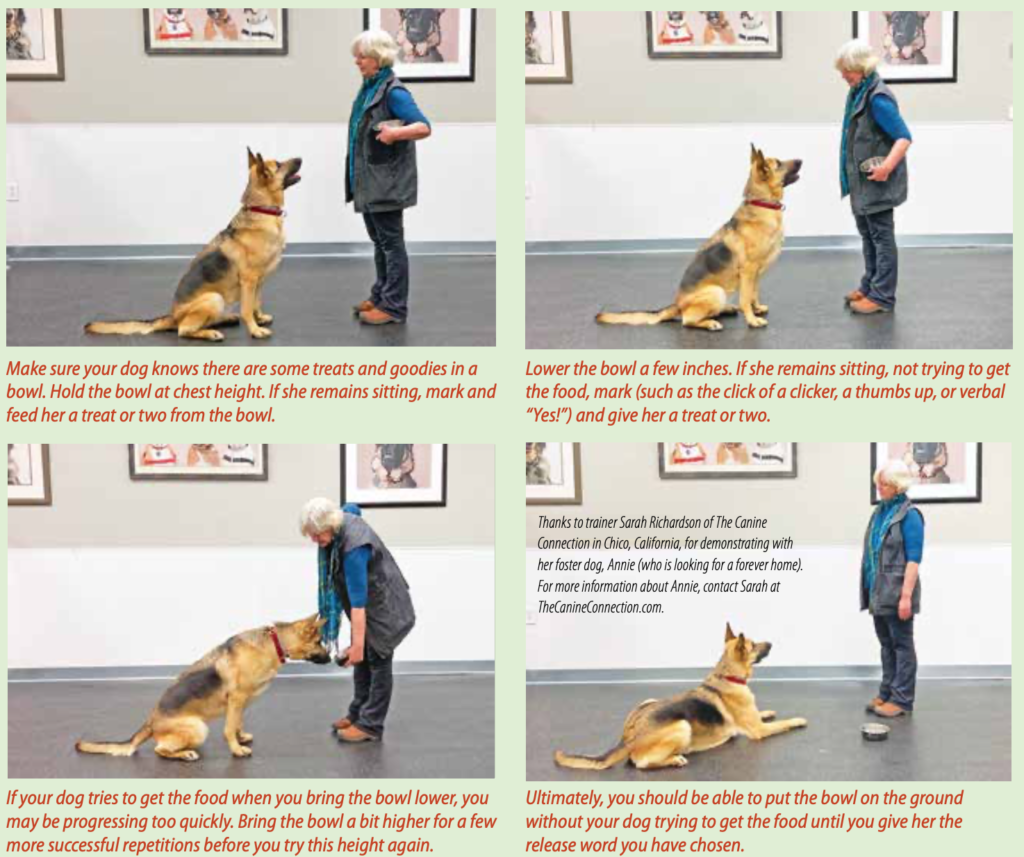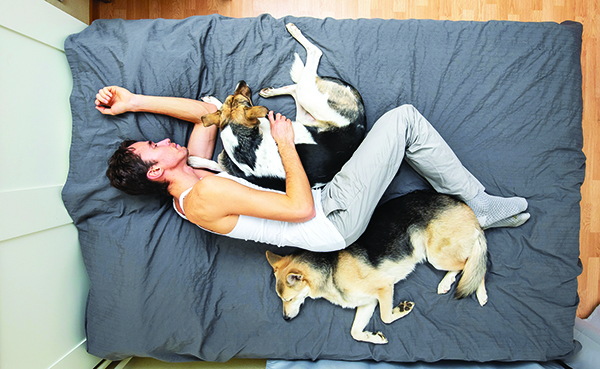Once upon a time, societal norms dictated that if pet dogs failed to comply with strict rules for their behavior indoors, they were banished to the outdoors. When I was a child, dog trainers of the day often told clients that allowing their dog on the bed or other furniture would give the dog too much privilege and let him think he could take over (dominate) the household.
Well, the times, they are a-changing.
These days, progressive, science-based, force-free training and behavior professionals recognize that most dogs are not trying to be dominant when on the couch; they are just trying to be comfortable – and perhaps want to be close to the humans they love!
You can use couch time as reinforcement for behaviors that you like (such as being friendly and cuddly) and temporarily revoke couch privileges for undesirable behaviors (such as being too pushy or insistent about climbing into your lap if you prefer your dog curl up quietly next to you). A cheerful, “Oops, off!” (with a treat tossed onto the floor if you haven’t yet taught the “Off” cue to your dog) will remove her from your lap, and a “Wait” cue will keep her on the floor until you are ready to invite her up. No dominance about it!
Also, the truth is, what you allow your dog to do in your own home is your choice – and while it may result in behaviors that others consider “bad manners,” that’s really up to you. In your house, you get to make the rules!
Here are some common rules from the past that many dogs (and their humans) now scoff at:
■ No dogs on the furniture. From 60 years ago to today, all the members of my family have allowed dogs on the furniture – and none of our dogs have ever staged a canine coup.
I love the solid feel of a warm dog’s body against my back in bed, and my evenings are generally spent on the sofa watching television and typing on my laptop, with our small dog Sunny snuggled up against my right side and medium/large Kai curled up on my left. I suspect Kai lived in a “No dogs on the furniture” household before he came to us; even after living with me and my husband for almost six years, I still have to reassure him that it’s okay to jump up on the sofa and often need to coax him up with a treat (although he jumps on the bed with no coaxing needed).
Of course, if you choose not to have dogs (and dog hair, drool, dirt, and leaves) on your furniture, that’s fine, too. But you are missing out on one of the greatest joys of sharing your home with a dog! We keep our furniture covered and whisk the covers off when company comes to reveal pristine furniture underneath.
Note: If allowing your dog on the furniture contributes to an inappropriate behavior such as growling as someone approaches, then you may need to restrict furniture access while you work to modify the behavior. See “Changing a Resource-Guarder,” WDJ May 2020, and “Resource-Guarding and What to Do About It,” August 2015, for more information about management and training protocols for this behavior.
■ No begging at meals. When I was a child, my mom often complained about my dad’s habit of feeding food scraps to our dogs from the table – but he did it anyway. This dynamic is intact in my home some 50-plus years later, as my husband Paul freely tosses bits of cheese, veggie sticks, popcorn, and whatever else he might be eating to our dogs. Sunny and Kai politely sit six or eight feet back from his chair, waiting in eager anticipation for the next tidbit.
While I freely share treats with my dogs throughout our days together, I choose to not feed them while I am eating my meals, and hence they never “beg” from me while I eat.
The good news: Dogs can learn to be attentive to one treat-dispensing family member and not bug others.
If you want to ensure your canine family members don’t get too pushy for treats but you’d still like to toss them a bit of your food from time to time, you can use mat training to teach them some impulse control along with their proximity to your table and the delicacies thereon. (See “Useful Matters,” January 2020.)

■ No jumping up. I used to be as adamant as anyone about teaching my dogs to greet people politely – and we still teach polite greetings in the Basic Good Manners classes taught at my training center. However, Sunny, our 25-pound Pomeranian/American Eskimo Dog-mix, has convinced us there can be value in having your dog jump up.
For one thing, Sunny is reasonably small and there’s generally no real harm done if he puts his paws up on you. For another, when he came to us, he was somewhat wary of new people, especially men (including Paul), and I didn’t want to discourage him from interacting with people in any way. Finally, he delights in leaping up in the air so I can catch him in my arms, and that’s just so darn cute I don’t have the heart to discourage the behavior. In fact, we show it off to friends.
You can still teach your dog to greet people politely but also teach her a “jump up” cue, making sure she gets reinforced for jumping up only if she’s asked to do so. This is especially helpful if one or more family members enjoy having the dog jump up on them. (For more about teaching a polite greeting, see “Meet and Greet? Or Not!” September 2018.)
■ Only go to the bathroom outdoors. Whaaat? Is there any other acceptable alternative to this?
Actually, there is! People who live in in highrise buildings sometimes find it to be near impossible to get their dogs outside in time; in this case, it makes sense to create a “legal” indoor canine bathroom.
This doesn’t mean the dog can go anywhere she wants in the apartment; there is still a designated place to eliminate. There is a variety of indoor litter boxes and types of absorbent substrate for dogs available in pet specialty stores and online. Some use litter, some use artificial grass, and some use real grass. Just Google “dog litter box” to find them.
■ No barking. It’s interesting to note how many of the old rules have to do with natural, normal canine behaviors. Sadly, far too many trainers today encourage their clients to use “no-bark” collars (shock or spray) to punish their dogs for barking, rather than allowing dogs to bark when it’s appropriate and teaching them to be quiet when it’s not. (See “Why Dogs Bark and How to Stop Them,” March 2017.)
We happen to have two dogs who are quite adept at barking, and both of them have high-pitched barks that can grate on your nerves. We’re fortunate that we live smack dab in the middle of our 80-acre farm; I can turn them out in the backyard and if they choose to bark at the horse in the pasture behind their fence, or wildlife in the woods, no one will complain.
When we are in the house, I do appreciate them barking to let me know that someone has pulled in the driveway (I can’t hear the cars drive in, but they can). However, the arousal/excitement barking when we head toward the door to go to the barn can get on my nerves. We’re working on that one.
MY HOUSE RULES

Lest you get the impression that my dogs are unruly monsters who run amok in our home, let me assure you that is not the case. We do have rules, just not the same rules that were once commonplace in many dog homes:
■ Wait for the food bowl. Not only is this just a polite behavior and the easiest way to teach a “Wait” behavior, it’s also an excellent impulse-control exercise and keeps feeding-time chaos to a minimum.
The chaos part was more important for us in past years when we had five dogs, but it’s helpful even with our current two. Sunny and Kai each go to their feeding spots while I prepare their meals and offer a default sit as I approach them to feed. I cue them to “Wait,” place the bowl on the floor, mark with a “Yes,” feed a treat, and then say “Okay” and release them to eat. (See “Wait for the Food Bowl,” next page.)
■ Wait at the door. This life-saving rule applies at every door that goes to the outside world, as well as getting out of the car. It’s easy to teach and is great insurance against door-darting. Sunny and Kai have gotten so good at it we can even leave barn gates open while we’re feeding horses and they don’t go out unless invited. If you have already taught “Wait for the Food Bowl,” it’s a pretty simple matter to generalize it to doors and other places.
■ Wait at the top of the stairs.
I like this one because it allows me to make my way safely down the stairs without worrying about tripping over excited dogs. Again, it is simple to generalize this one quickly if your dog already knows “Wait” in a different application. Start at the top of the stairs, tell your dog to “Wait,” go down one step, mark, return and feed. Continue one step at a time until you’re all the way down, then invite your dog(s) to join you.
■ No wrestling in the house. There’s nothing wrong with allowing your dogs to roughhouse indoors if that’s what you want; I just prefer they do their wrestling outside. They play hard together in the barn and have learned that I will put them in the backyard if they wrestle indoors, so they now use it to let me know they want to – or have to – go outside. I love that they have taught me a cue!
■ No indoor arousal barking. Okay, true confession time: We are still working on this one.
It wasn’t a problem until Sunny arrived in our home two years ago, but he can be quite vocal, and when he starts, Kai happily joins in.
I judiciously use treats for “quiet” (positive reinforcement – dog’s behavior makes a good thing happen) and halt forward progress and turn my back when barking erupts (negative punishment – dog’s behavior makes a good thing go away). By using these complementary tactics, I can now make it down the stairs and out the back door on the way to the barn at 6 in the morning without a cacophony of barking. I’m sure when this pandemic is over and we once again have house guests, they will appreciate that.
Other than those, we of course have the normal, obvious house rules – no chewing on things you’re not supposed to chew on, no getting up on the counters, no chasing the cats, no getting in the garbage, etc. But overall, having fewer rules and allowing your dog to make more of her own choices in your home makes for a behaviorally healthier companion and a better relationship between the two of you. So yes, have the rules that you need and want, but don’t let anyone else tell you what they should be. It’s your house; you get to make the rules.
What do I most appreciate about the “Wait” behavior? It’s easy for dogs to learn and easy for them to generalize “Wait!” to a variety of situations in which you want them to pause where they are for a few moments, until given a cue to proceed.
Here’s how to teach this highly useful behavior:
1. With your dog sitting, facing you, hold her bowl at chest level (with food in it, topped with tasty treats) and say “Wait.”
2. Lower the food bowl toward the floor two inches. If your dog remains sitting, click your clicker (or use a verbal marker, such as the word “Yes!”), raise the bowl back up again, and feed her a treat from the bowl. If she gets up, say “Oops” and ask her to sit again. If she remains in place, lower the bowl two inches again, mark (click or “Yes!”), raise the bowl, and treat.
3. Repeat this step several times until she remains sitting as you lower the bowl. Mark and treat each time.
4. Gradually move the bowl closer to the floor with succeeding repetitions until you can place it on the floor two feet away from her and pick it back up without her getting up or trying to eat it.
5. Finally, place the bowl on the floor and say a release cue to tell her to eat. Note: Choose your release cue carefully. Many people use “Okay!” as their release cue, but a common word like this may accidentally release your dog when you are casually speaking to someone as the dog waits. Consider alternatives such as “Free!” or “Done!”
A really helpful thing about teaching this behavior is that you have at least one built-in daily practice session (possibly two, since many of us feed our dogs twice a day). To teach other Wait applications, break the behavior down to small steps: Wait while you reach for the door. Wait while you jiggle the doorknob. Wait while you open the door a crack. Wait while you open it a little farther. And so on.







Your essay on the new approach to “house rules” couldn’t have been more timely. As a volunteer in a greyhound adoption group, one of the foster folks I work with is fostering an uber anxious young grey. She allows him on the couch with her and in her bed, what she calls his “safe places.” She has not described any resource guarding. The adoption group’s rule is no foster dog is allowed on the furniture (the potential adopter might not like that/it’s a hard habit to change and fear of promoting resource guarding). Her foster dog recently bit her when she tried to corral him in a yard when playtime was over. She has been disparaged for allowing the foster on the furniture as though it somehow led to the fear bite. Thank you for confirming my feeling that the two were unrelated.
It’s a great article, I must add that your comment is very interesting as well 🙂
This article is perfect. My niece and I want to introduce her Minnie, black lab (5 y.o.) and my Cooper, Chesapeake Bay, (5 y.o.). We were planning a play date, but I think we need an introductory session or sessions before a play date, if any. I sent the article to my niece. Thank you so much for this article. Will help us move forward with the canine meeting and better humans to our canines.
I love this article! I am divorced and live alone with my Lulu. She is a Lab/Shepherd mix that weighs about 110 lbs. Her and her recently deceased brother Bear share my California king bed and other furniture. Bear weighed about 90 lbs and when he could no longer hop into bed I took the mattress off the frame so he wasn’t left out. God knocked it out of the park when he created dogs and they love you the way He does. Unconditionally!
Very well-said! Thanks for sharing!
My lab is a boy and he weight 180 lbs.my boy he is so adorable.
I enjoyed your article stressing freedom of choice regarding acceptable pet behavior in your own home. I fail to understand, why out of all the behaviors listed, freedom to allow begging from the table is not acceptable even though it is my house my rules. Seems to me it’s freedom of choice as long as you choose what the author deems acceptable.